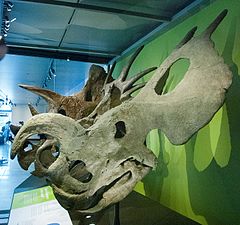Einiosaurus procurvicornis
|
Einiosaurus Temporal range: Upper Cretaceous, 74.5–74 Ma |
|
|---|---|
 |
|
| Reconstructed skull, Los Angeles Natural History Museum | |
| Scientific classification | |
| Kingdom: | Animalia |
| Phylum: | Chordata |
| Clade: | Dinosauria |
| Order: | †Ornithischia |
| Family: | †Ceratopsidae |
| Subfamily: | †Centrosaurinae |
| Tribe: | †Pachyrhinosaurini |
| Genus: |
†Einiosaurus Sampson, 1995 |
| Species: | †E. procurvicornis |
| Binomial name | |
|
Einiosaurus procurvicornis Sampson, 1995 |
|
Einiosaurus is a medium-sized herbivorous centrosaurine ceratopsian dinosaur from the Upper Cretaceous (Campanian stage) of northwestern Montana. The name means 'buffalo lizard', in a combination of Blackfeet Indian eini and Latinized Ancient Greek sauros; the specific name (procurvicornis) means 'with a forward-curving horn' in Latin.
Einiosaurus was a herbivorous dinosaur. In 2010 Gregory S. Paul estimated its body length at 4.5 metres, its weight at 1.3 tonnes. Its snout is narrow and very pointed. It is typically portrayed with a low, strongly forward and downward curving nasal horn that resembles a bottle opener, though this may only occur in some adults. The supraorbital (over-the-eye) horns are low, short and triangular in top view if present at all, as opposed to the chasmosaurines, such as Triceratops, which have prominent supraorbital horns. A pair of large spikes, the third epiparietals, projects backwards from the relatively small frill. Smaller osteoderms adorn the frill edge. The first epiparietals are largely absent.
Einiosaurus is an exclusively Montanan dinosaur, and all its known remains are currently held at the Museum of the Rockies in Bozeman, Montana. At least fifteen individuals of varying ages are represented by three adult skulls and hundreds of other bones from two low-diversity (one species) bonebeds, which were discovered by Jack Horner in 1985 and excavated from 1985-1989 by Museum of the Rockies field crews. These bonebeds were originally thought to contain a new species of Styracosaurus and are referred to as such in the comprehensive taphonomic study by Ray Rogers from 1990. The same year Stephen Czerkas published the name Styracosaurus makeli, honouring Robert Makela, but without description so that it remained an invalid nomen nudum. In 1992 Horner discerned three species in the material from the bonebeds in this region, that he indicated as Type A, B and C. In 1995 Scott D. Sampson formally described and named Type B as the type species Einiosaurus procurvicornis; in the same article he named Type C as Achelousaurus horneri. The holotype of Einiosaurus is MOR 456.
...
Wikipedia
